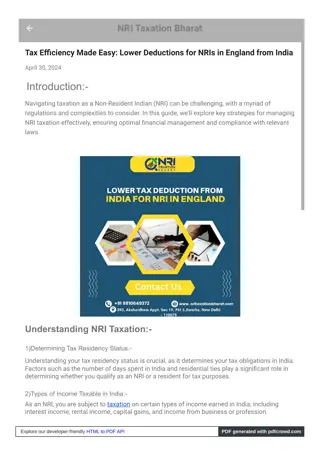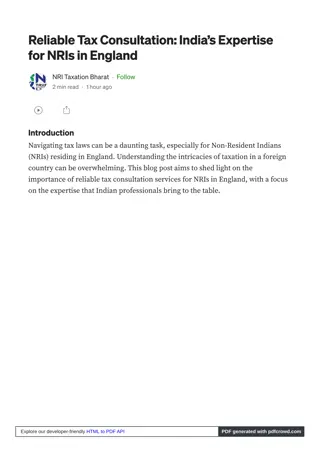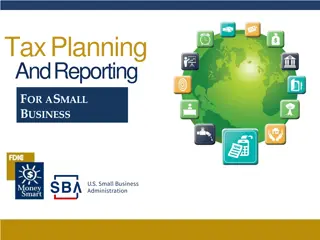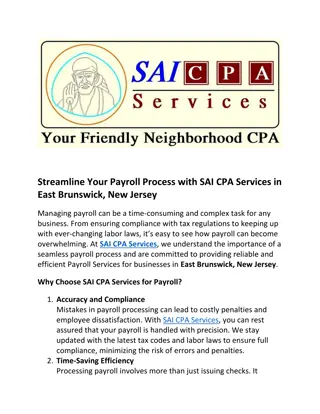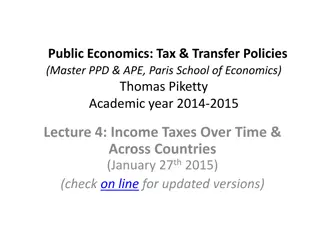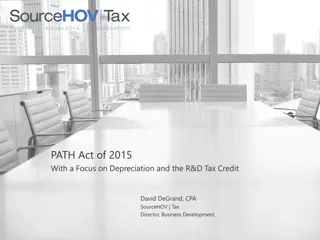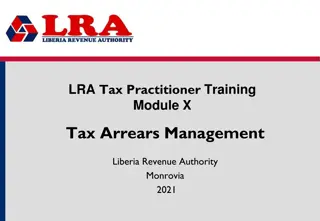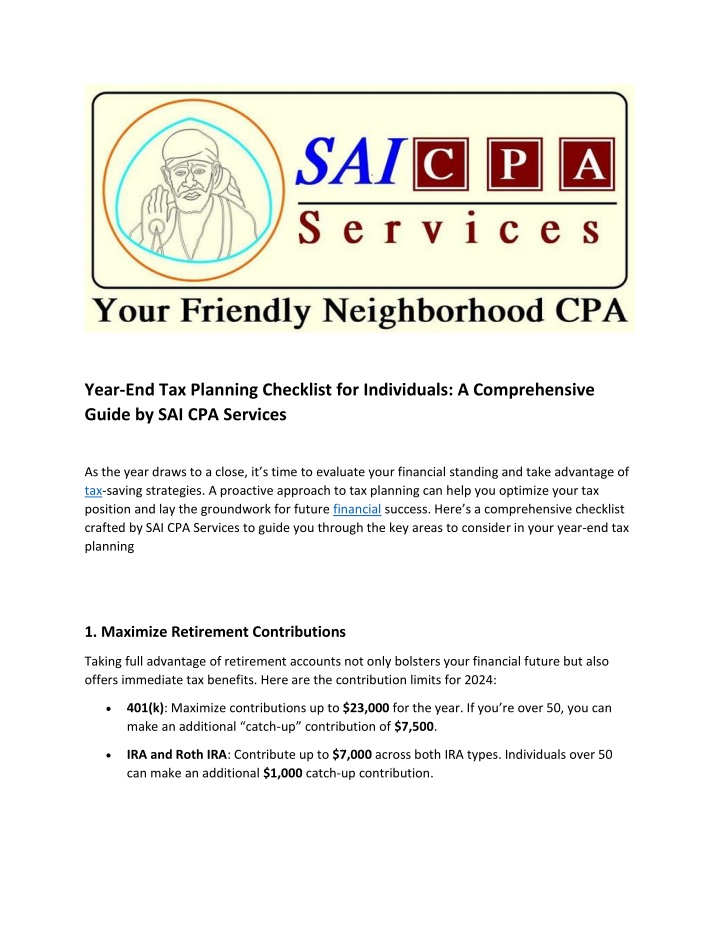
Year-End Tax Planning Checklist for Individuals: A Comprehensive Guide by SAI CP
As the year draws to a close, itu2019s time to evaluate your financial standing and take advantage of tax-saving strategies. A proactive approach to tax planning can help you optimize your tax position and lay the groundwork for future financial suc
Uploaded on | 4 Views
Download Presentation

Please find below an Image/Link to download the presentation.
The content on the website is provided AS IS for your information and personal use only. It may not be sold, licensed, or shared on other websites without obtaining consent from the author. If you encounter any issues during the download, it is possible that the publisher has removed the file from their server.
You are allowed to download the files provided on this website for personal or commercial use, subject to the condition that they are used lawfully. All files are the property of their respective owners.
The content on the website is provided AS IS for your information and personal use only. It may not be sold, licensed, or shared on other websites without obtaining consent from the author.
E N D
Presentation Transcript
Year-End Tax Planning Checklist for Individuals: A Comprehensive Guide by SAI CPA Services As the year draws to a close, it s time to evaluate your financial standing and take advantage of tax-saving strategies. A proactive approach to tax planning can help you optimize your tax position and lay the groundwork for future financial success. Here s a comprehensive checklist crafted by SAI CPA Services to guide you through the key areas to consider in your year-end tax planning 1. Maximize Retirement Contributions Taking full advantage of retirement accounts not only bolsters your financial future but also offers immediate tax benefits. Here are the contribution limits for 2024: 401(k): Maximize contributions up to $23,000for the year. If you re over 50, you can make an additional catch-up contribution of $7,500. IRA and Roth IRA: Contribute up to $7,000 across both IRA types. Individuals over 50 can make an additional $1,000 catch-up contribution.
Ensuring you reach these contribution limits can significantly reduce your taxable income, allowing you to save more while planning for retirement. If you re unsure how to allocate funds across different retirement accounts, we re here to help. 2. Implement Strategic Investment Moves Year-end is an ideal time to assess your investment portfolio for tax-saving opportunities: Tax-Loss Harvesting: Sell underperforming investments to offset capital gains and reduce your taxable income. You can use capital losses to offset gains dollar-for-dollar, up to a limit of $3,000 per year for individual filers. Portfolio Rebalancing: Rebalance your portfolio to align with your investment goals and risk tolerance. This may involve reallocating assets among stocks, bonds, and other investment types to ensure a diversified strategy. At SAI CPA Services, we can guide you in leveraging investment strategies for optimal tax efficiency. 3. Charitable Contributions Charitable donations are not only a way to give back but can also result in significant tax deductions: Donor-Advised Funds (DAFs): Establishing a DAF allows you to make a large, tax- deductible contribution to the fund and recommend grants to charities over time. Appreciated Assets: Donating appreciated stocks or securities directly to charity helps avoid capital gains tax, allowing the charity to receive the full value of your donation. Qualified Charitable Distributions (QCDs): For individuals over 70 , a QCD allows you to make a direct donation from your IRA (up to $100,000 annually) to a qualified charity. QCDs can satisfy your required minimum distribution (RMD) and are not included in your taxable income. Our team can help you structure your charitable giving for maximum tax impact. 4. Estate and Gift Planning Effective estate planning can secure your wealth and ensure it benefits your loved ones as intended:
Annual Gift Exclusion: Gift up to $18,000 per recipient without triggering gift taxes (or $36,000 per recipient for married couples gifting jointly). Estate Plan Review: Review and update your estate plan to account for life changes, new assets, or adjustments in beneficiaries. 5. Take Advantage of Education Tax Credits Educational expenses can qualify for valuable tax credits: American Opportunity Tax Credit (AOTC): This credit allows you to claim up to $2,500 per eligible student for qualified education expenses, such as tuition, fees, and course materials. Lifetime Learning Credit (LLC): The LLC offers up to $2,000 per return for eligible education expenses, including courses for job skills improvement. If you or a family member has qualifying education expenses, ensure you take advantage of these credits. 6. Energy-Efficient Home Improvements Home upgrades can yield tax benefits through the Residential Energy Credits: Energy Efficient Upgrades: If you ve made home improvements such as installing solar panels, wind turbines, or energy-efficient windows and doors, you may qualify for credits. These credits can reduce your tax liability while helping you save on energy costs. 7. Leverage Miscellaneous Deductions Various deductions can reduce your taxable income, including: Mortgage Interest Deduction Medical Expenses: Deduct unreimbursed medical expenses that exceed 7.5% of your Adjusted Gross Income (AGI). State and Local Tax (SALT) Deduction: You can deduct up to $10,000 in combined property, state, and local taxes. Understanding which deductions apply to your situation can make a significant difference.
8. Prepare for Major Life Events Certain life changes have tax implications, and preparation is essential: Marriage or Divorce: Changes in marital status can affect filing status, standard deductions, and eligibility for tax credits. Birth or Adoption: Having a new dependent can increase tax credits and potentially reduce your tax burden. 9. Report Foreign Financial Accounts and Assets If you have foreign financial accounts or assets, ensure compliance with FBAR and FATCA reporting requirements: FBAR: If you have foreign accounts with a combined value exceeding $10,000, file a Report of Foreign Bank and Financial Accounts (FBAR). FATCA: Report foreign financial assets over $50,000 (for single filers) to the IRS. Penalties for non-compliance can be significant, so review all accounts and report accordingly. 10. Income Management If you re able to shift income or accelerate deductible expenses, it may be beneficial to do so before the end of the year: Income Shifting: If possible, defer income to the following year to reduce current tax liability. Accelerate Deductions: Prepay certain deductible expenses, such as medical bills or property taxes, to claim deductions in the current tax year. Year-end tax planning can be complex, but with the right guidance, it can also be highly beneficial. Contact SAI CPA Services today to maximize your tax savings, protect your assets, and plan for the future. Our team of experienced CPAs is here to help you make informed, strategic financial decisions.

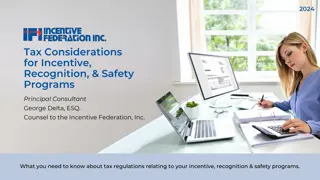
![Town of [Town Name] Real Estate Tax Rates and FY 2024 Budget Summary](/thumb/62211/town-of-town-name-real-estate-tax-rates-and-fy-2024-budget-summary.jpg)
